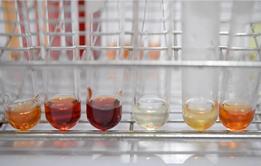Illustrate the reversible reaction between bismuth(III) oxychloride and bismuth(III) chloride in this demonstration
Solid bismuth(III) oxychloride (bismuth(III) oxide chloride) and bismuth(III) chloride (bismuth trichloride) in solution can exist in equilibrium:
BiOCl(s) + 2HCl(aq) ⇌ BiCl3(aq) + H2O(l)
In this experiment, students observe as bismuth(III) oxychloride is dissolved in concentrated hydrochloric acid to give a clear solution of bismuth(III) chloride. They then see how the addition of water re-forms the bismuth(III) oxychloride as a white precipitate, and how the subsequent addition of hydrochloric acid increases the chloride ion concentration and re-dissolves the precipitate.
These reversible changes can be repeated several times in sequence.
This demonstration involves an unfamiliar reaction, but bismuth compounds do have everyday uses in medicines for indigestion and diarrhoea, and in cosmetics. The reaction provides a visible demonstration of an easily reversible reaction. A detailed equation for the reaction may not even be necessary for use with all groups.
Alternately decreasing and increasing the hydrochloric acid concentration causes the equilibrium to shift in the direction predicted by Le Chatelier’s principle.
A dark background will make the changes more easily visible.
The time required is about five minutes if the solution is prepared beforehand and beakers and measuring cylinders are lined up on the bench.
Equipment
Apparatus
- Eye protection (goggles)
- Beakers, 25, 50, 100, 250, 600 and 2000 cm3, 1 of each (see note 6 below)
- Measuring cylinders, 10 cm3, x4 (see note 7)
- Measuring cylinders, 50 or 100 cm3, x2 (see note 7)
- Boiling tube
- Stirring rod
- Top pan balance, accurate to +/– 0.1 g
Chemicals
- Bismuth(III) oxychloride (OXIDISING, IRRITANT), 2.6 g
- Concentrated hydrochloric acid (CORROSIVE), 83 cm3
Health, safety and technical notes
- Read our standard health and safety guidance.
- Wear eye protection (goggles) throughout.
- Bismuth(III) oxychloride, BiOCl(s) (OXIDISING, IRRITANT) – see CLEAPSS Hazcard HC073D.
- Bismuth(III) chloride, BiCl3(s) (CORROSIVE, DANGEROUS FOR THE ENVIRONMENT) – see CLEAPSS Hazcard HC073D.
- Concentrated hydrochloric acid, HCl(aq) (CORROSIVE) – see CLEAPSS Hazcard HC047a.
- These sizes are not critical, the size larger than that specified could easily be substituted in each case.
- It is possible to manage with just one cylinder of each size by measuring the acid out into suitably sized beakers.
Procedure
Before the demonstration
- Weigh out 2.6 g (0.01 mol) of bismuth(III) oxychloride. Dissolve the bismuth(III) oxychloride in 3 cm3 of concentrated hydrochloric acid in a boiling tube or small beaker. This will give a clear solution of bismuth(III) chloride.
- Line up on the demonstration bench six beakers of the sizes shown containing water as shown in the table. Beside each beaker place a measuring cylinder (or other suitable container such as a small beaker) containing the volume of concentrated hydrochloric acid shown in the table.
| Beaker number | Size of beaker / cm3 | Volume of water in beaker / cm3 | Volume of conc. HCl next to beaker / cm3 |
|---|---|---|---|
| 1 | 25 | 12 | 2 |
| 2 | 50 | 25 | 2 |
| 3 | 100 | 50 | 3 |
| 4 | 250 | 125 | 7 |
| 5 | 600 | 300 | 16 |
| 6 | 2000 | 1000 | 50 |
The demonstration
- Pour the bismuth(III) chloride solution into the water in beaker 1. A white precipitate of bismuth(III) oxychloride will appear immediately as the equilibrium is displaced to the left by the increased concentration of water and reduction of the acid concentration.
- Now add the 2 cm3 of hydrochloric acid to beaker 1 and stir. The precipitate re-dissolves as bismuth(III) chloride, as the increased concentration of acid moves the equilibrium to the right.
- Now pour the contents of beaker 1 into beaker 2. The precipitate re-appears and can be dissolved again on addition of the pre-measured volume of hydrochloric acid, with stirring.
- Pour the contents of beaker 2 into beaker 3, followed by addition of acid and so on. Precipitates continue to appear and re-dissolve as predicted by Le Chatelier’s principle although the precipitate takes noticeably longer to re-dissolve.
Teaching notes
The experiment can be started from a solution of bismuth(III) chloride in water if bismuth(III) oxychloride is not available.
The demonstration can be carried out more quickly and qualitatively as a test tube reaction, starting with a little bismuth(III) chloride dissolved in about 1 cm3 of concentrated hydrochloric acid. Adding water to a few drops of this solution produces a white precipitate. This can be reversed by adding more concentrated acid. By trial and error suitable volumes can be found that will enable the cycle to be reversed several times.
Point out that the reaction to re-establish equilibrium gets slower as the solutions get more dilute.
Additional information
This is a resource from the Practical Chemistry project, developed by the Nuffield Foundation and the Royal Society of Chemistry.
Practical Chemistry activities accompany Practical Physics and Practical Biology.
© Nuffield Foundation and the Royal Society of Chemistry
Equilibrium and Le Chatelier’s principle

Investigate the effects of concentration, pressure and temperature on equilibrium and explore Le Chatelier’s principle in this series of demonstrations.
- 1
 Currently
reading
Currently
reading
The effect of concentration on equilibrium
- 3
- 4

























No comments yet